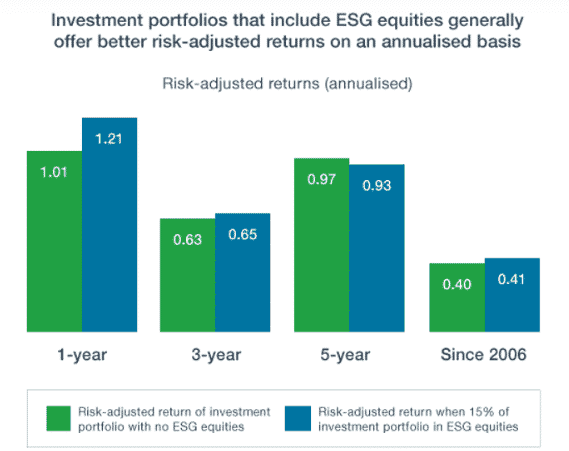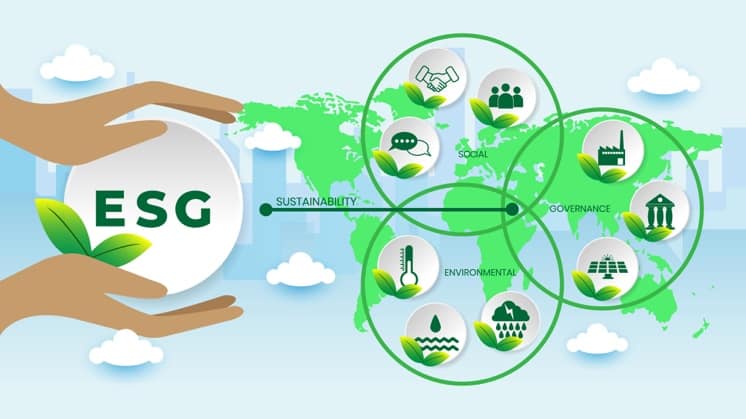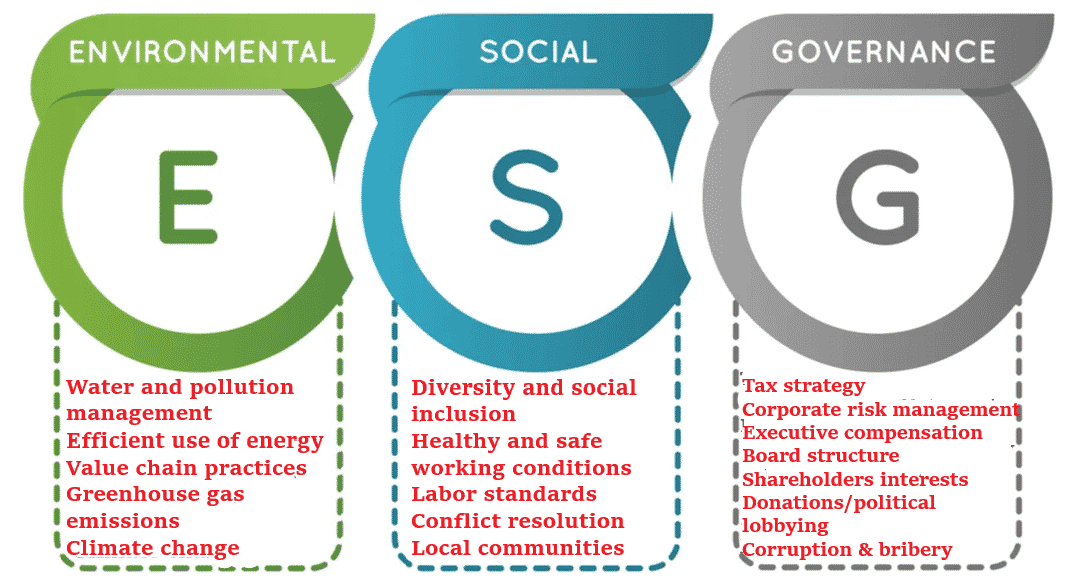What does ESG mean? What is the definition of ESG and why invest using its criteria?
Investors have been asking these questions wondering if ESG is the same as CSR. Or how it compares with socially responsible investing and impact investing.
If you also want to know what ESG means, this guide provides a comprehensive definition of the concept. It will also help you understand why using ESG criteria in making investments is all worth it.
ESG Definition and Meaning
ESG is an acronym for Environmental, Social, and Governance. It refers to the three major criteria used to measure the sustainability of an investment in a business or project.
ESG is a generic term used by investors to assess the behavior of companies and predict their future financial performance. Most socially responsible investors check companies out using ESG criteria to screen investments.
For instance, it’s used to ensure accountability and management of a firm’s carbon footprint. And the number of funds invested using the ESG criteria has been growing so much since the start of this decade.
With the carbon offsetting and credit industry expanding, there is more opportunity to track non-financial metrics for investors like greenhouse gas (GHG) emissions.
It’s expected to rise even more as the world shifts to a low carbon economy in response to climate change.
ESG vs. CSR: What’s the difference?
Most often the definition of ESG is taken the same as the concept of CSR – corporate social responsibility. While both terms are quite similar, they’re two different concepts.
CSR is a way of managing a company that accounts for the impact its business activity has on various stakeholders. These include its clients, employees, suppliers, investors, society, and other affected groups.
CSR is all about integrating ecological and social concerns into a firm’s business activities. At the same time, adopting a long-term vision over short-term values.
- ESG is more about capital markets where investors opt for companies that disclose their ESG strategies. While CSR focuses more on engaging stakeholders.
Yet both concepts care not only about profits, finances, and governance. They also consider the people and the planet to promote sustainability.
Most companies are including their CSR in their ESG reports. Reporting their ESG each year has been the practice for all large businesses, especially for the major airlines.
Those who don’t report their ESG metrics may find it hard to attract investors’ attention.
Responsible investors assess firms using the definition of ESG criteria to screen investments. They can also use it to assess risks in making their investing decisions.
So, let’s find out how companies act on the three ESG criteria: environmental, social, and governance by breaking down each one of them.
ESG Criteria: The Environmental Factors
In essence, environmental factors are about a company’s impact on the environment. They’re based on the idea that business activities can pose risks to the environment.
This criterion looks into how a business acts as a steward of the natural environment. Examples of a firm’s environmental factors can include:
- Waste and pollution management
- Efficient use of energy
- Value chain practices
- Greenhouse gas emissions
- Climate change
To fulfill this ESG factor, it’s not enough for businesses to only deal with the adverse impact of their activities.
Instead, they need to have a proactive approach that promotes the sustainability of natural resources.
The most pressing environmental concern right now for all businesses is climate change. And so, the common elements of ESG environmental definition include these key actions:
- The fight against deforestation
- Use of clean renewable energy
- Reducing GHG emissions
Almost all large businesses today include climate change in their annual ESG reports. In particular, this environmental component often details the company’s strategies for reducing its carbon footprint.
Common climate change strategies include nature-based solutions like avoiding deforestation. While other measures involve offsetting GHG emissions using carbon credits.
The major goal of this ESG factor is to improve profitability without harming the environment. Thus, investment decisions consider any environmental risks a business has. And investors favor projects that show care for the planet.
ESG Criteria: The Social Factors
A firm that follows this part of the ESG definition respects the rights of its employees and of other people affected by its activities. These include clients, business partners, and the local community people.
In other words, social factors have to do with how the company treats and values people as well as meeting the social inclusion criteria. This ESG criterion also involves concerns about employment conditions to protect workers’ welfare.
Overall, it’s all about the impact that a company has on its employees and on society as shown by these practices:
- Diversity and social inclusion policies that avoid discrimination
- Healthy and safe working conditions
- Labor standards across supply chains: fair wages and human rights protection
- Conflict resolution
- Good relations with local communities
As a result, firms that integrate social factors into their programs and projects tend to witness better outcomes. For instance, they’ll have high workers’ morale, increased productivity, and lower turnover.
Businesses with socially-responsible ESG practices also find it easier to do their activities. That’s because they don’t face social pressure from people who give them social license to operate.
ESG Criteria: The Governance Factors
This final ESG criterion focuses on corporate culture, policies, and governance. It is about making the responsibilities, rights, and expectations of stakeholders clear so that interests are met.
Values like managers showing commitment to fighting unethical or unfair practices are a strong part of the culture, for instance.
To assess this ESG factor needs clear governance policies and rules. Common examples under which this can be assessed include:
- Tax strategy/Fiscal and procedural transparency
- Corporate risk management
- Executive compensation
- Donations and political lobbying
- Corruption and bribery
- Board structure and brand independence
- Protecting shareholder interests
The great benefits of having these governance policies can cover a lot of things. And the biggest one is marrying shareholders’ interests with management to avoid financial pitfalls.
Overall, here are the three ESG criteria combined together.
ESG Criteria: Why use it when investing?
ESG definition and standards are becoming a notable consideration in today’s investment world.
This is because the ESG criteria deal with issues that are vital when measuring the impacts of investment other than financials. Plus, they also have a huge bearing on the rate of return and long-term risk of investment portfolios.
In fact, studies found that investors who choose ESG-screened investments enjoy a ‘double dividend’. This refers to having a lower risk plus a better rate of return or the ratio of income from an investment over cost.
Moreover, ESG investing may end up helping investors build a better investment allocation. It means integrating ESG sustainability factors results in lower risks.
For ESG-focused investing, this means that even if returns are similar, the same return the investor can have in taking less risk. The charts below support this point.

The graph above reveals that investments with ESG equities offer better returns for the level of risk taken in most cases.
The chart below shows that the top 20 ESG funds enjoyed rising return contributions due to better ESG performance (ESG factor return).

Different reasons explain why is that so. Others say that businesses that embrace ESG standards tend to face lower costs of capital and have greater transparency.
While some believe that ESG reduces the risk as investors put their money in projects with a higher chance of success in the long run.
So traditional investors are now becoming more interested in ESG investing framework, too. And many had started using the ESG criterion on environmental aspects to favor investments that reduce carbon emissions.
Using ESG Funds to Reduce Carbon Emissions
ESG factors are a subset of non-financial performance indicators like managing carbon footprint. And this has been the case for many years since the bad effects of climate change were felt.
In fact, a manager of a global investment company wrote that:
“The big picture is that in the next few decades the global economy is going to transform to a low-carbon economy… And it will be one of the biggest investment events of our lifetime.”
A survey of hundreds of investors with over $700,000 confirmed such a claim. Most investors revealed interest in pumping their money into climate-related investments.
Indeed, projects that produce carbon credits are growing globally to cut down emissions. In fact, it’s now valued at over $850 billion and will grow to $22 trillion by 2050.
ESG investing and carbon credits both aim to align climate goals with sustainable investments. Carbon credits are tradeable permits given to companies to offset their GHG emissions. They’re a market-based mechanism for companies to cut their emissions.
- In general, one credit equals one metric ton of allowed carbon dioxide emission.
Investing in carbon credits is a popular option for businesses to collectively fight climate change by slashing emissions.
As noted earlier, climate change and GHG emissions are ESG themes under the environmental aspect. But why use ESG funds to invest in carbon credits?
Here are some compelling reasons why:
- Empower businesses and investors to address their climate impact
- Put a price on carbon emitted into the air, which incentivizes firms and people alike to further reduce emissions
- Enable companies to manage their carbon impact cost-effectively
- Bring environmental and economic benefits to local communities where projects take place
- Provide income stream for project developers by making emission reduction projects more viable
All these reasons are valid under the definition of ESG and its criteria. So no wonder why ESG-focused investors are lining up in climate-related projects that produce carbon credits.
To learn all about ESG investing, this site is so useful. To know more about how to invest in carbon credits, read our complete guide here.
And if you need help in deciding what type of carbon credits to choose, here’s our full guide for that.


